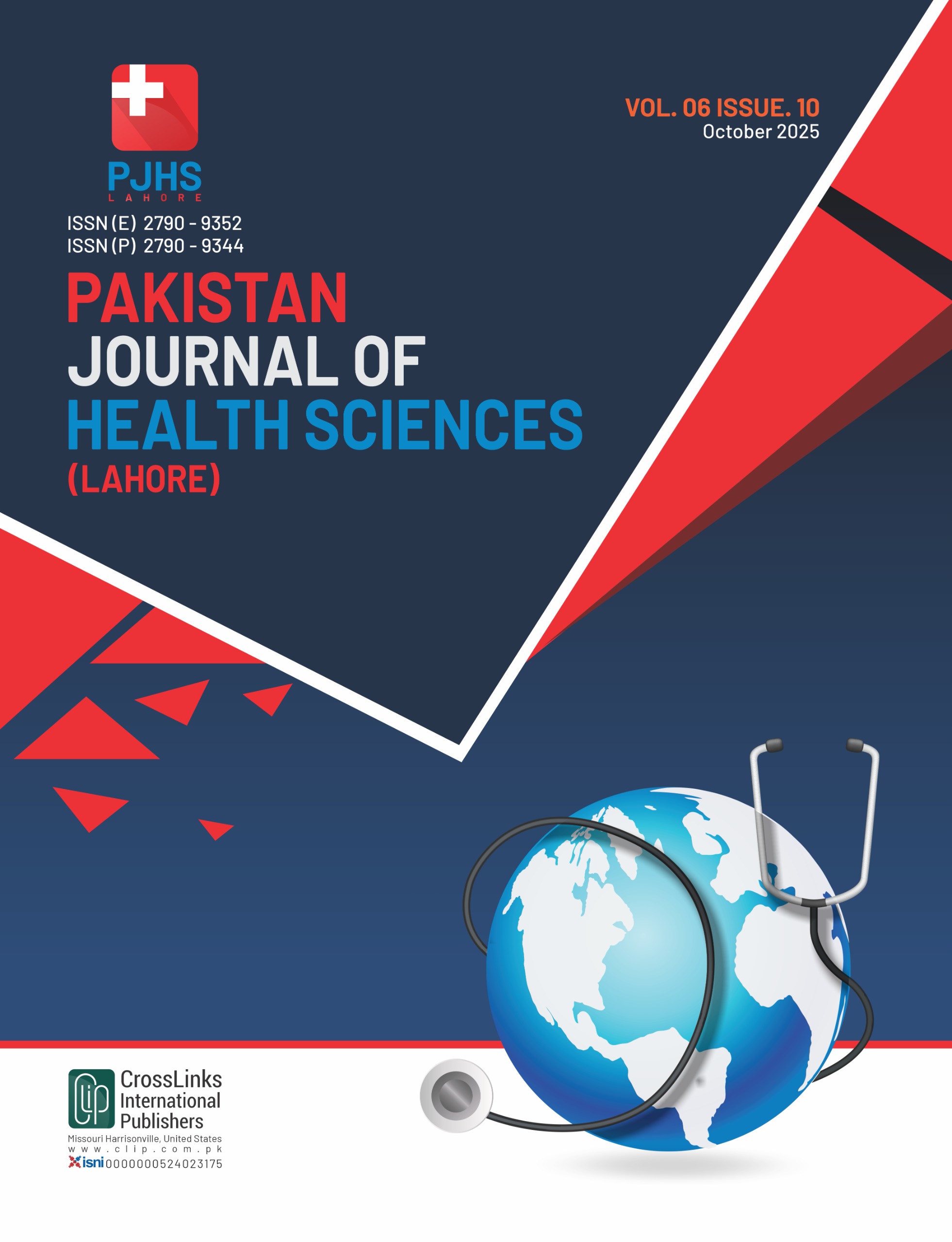Urinary Vitamin D-Binding Protein as a Diagnostic Marker for Diabetic Nephropathy in Type 2 Diabetic Patients
Urinary VDBP in Diabetic Nephropathy
DOI:
https://doi.org/10.54393/pjhs.v6i10.3159Keywords:
Normoalbuminuria, Microalbuminuria, Albumin to Creatinine Ratio, Vitamin D Binding ProteinAbstract
In T2DM (Type 2 Diabetes Mellitus), the most common microvascular complication is DN (Diabetic Nephropathy). Objectives: to explore uVDBP (urinary vitamin D-binding protein) for the detection of DN. Methods: This cross-sectional comparative study was conducted in the Chemical Pathology Department, University of Health Sciences, Lahore. The study individuals were mainly categorized into three groups. Group 1 included normoalbuminuric non diabetic control subjects with normal ACR <30mg/g (n=25). Group 2 included normoalbuminuric T2DM patients with normal ACR <30mg/g (n=25). Group 3 comprised microalbuminuric T2DM patients with raised ACR 30 to 299 mg/g (n=25). Spot urine specimens were collected from T2DM patients. The patients were recruited from the Sheik Zayed Hospital Diabetic Clinic, Lahore. Collected data was analyzed by using SPSS version 24.0. Kruskal-Wallis test, Dunn-Bonferroni post-hoc analysis, and Spearman’s correlation were applied. Results: The findings indicated the Urinary Vitamin D-Binding Protein (uVDBP) level was high in patients with microalbuminuria and normoalbuminuria compared to the control group. Group 3 had the highest median Urinary Vitamin D-Binding Protein (uVDBP) concentration, which was higher than in group 2 and group 1. Among all three groups, there was a statistically significant difference in levels of ACR (Albumin-to-Creatinine Ratio) and urinary Vitamin D-Binding Protein (p value = 0.000). Conclusions. In conclusion, the levels of urinary vitamin-D binding protein are significantly increased in T2DM patients having normoalbuminuria and microalbuminuria compared to non-diabetic control subjects. A significant positive correlation was observed between Urinary Vitamin D-Binding Protein (uVDBP) and albumin creatinine ratio.
References
Dilmurodovna TD. Diabetes Mellitus in Central Asia: Problems and Solutions. Best Intellectual Research. 2024; 12(4): 204–13.
Farooqi A, Gillies C, Sathanapally H, Abner S, Seidu S, Davies MJ, et al. A Systematic Review and Meta-Analysis to Compare the Prevalence of Depression Between People with and without Type 1 And Type 2 Diabetes. Primary Care Diabetes. 2022 Feb; 16(1): 1–10. doi: 10.1016/j.pcd.2021.11.001. DOI: https://doi.org/10.1016/j.pcd.2021.11.001
Ortiz-Martínez M, González-González M, Martagón AJ, Hlavinka V, Willson RC, Rito-Palomares M. Recent Developments in Biomarkers for the Diagnosis and Screening of Type 2 Diabetes Mellitus. Current Diabetes Reports. 2022 Mar; 22(3): 95–115. doi: 10.1007/s11892-022-01453-4. DOI: https://doi.org/10.1007/s11892-022-01453-4
Chen M, Pu L, Gan Y, Wang X, Kong L, Guo M, et al. The Association Between Variability of Risk Factors and Complications in Type 2 Diabetes Mellitus: A Retrospective Study. Scientific Reports. 2024 Mar; 14(1): 6357. doi: 10.1038/s41598-024-56777-w. DOI: https://doi.org/10.1038/s41598-024-56777-w
Pelle MC, Provenzano M, Busutti M, Porcu CV, Zaffina I, Stanga L, Arturi F. Update on Diabetic Nephropathy. Life. 2022 Aug; 12(8): 1202. doi: 10.3390/life12081202. DOI: https://doi.org/10.3390/life12081202
Imtiaz S, Alam A. Epidemiology and Demography of Chronic Kidney Disease in Pakistan: A Review of Pakistani Literature. Pakistan Journal of Kidney Diseases. 2023 Mar; 7(1): 2–7. doi: 10.53778/pjkd71209. DOI: https://doi.org/10.53778/pjkd71209
Kumar M, Dev S, Khalid MU, Siddenthi SM, Noman M, John C, et al. The Bidirectional Link Between Diabetes and Kidney Disease: Mechanisms and Management. Cureus. 2023 Sep; 15(9). doi: 10.7759/cureus.45615. DOI: https://doi.org/10.7759/cureus.45615
Samsu N. Diabetic Nephropathy: Challenges in Pathogenesis, Diagnosis, and Treatment. BioMed Research International. 2021; 2021(1): 1497449. doi: 10.1155/2021/1497449. DOI: https://doi.org/10.1155/2021/1497449
Résimont G, Cavalier E, Radermecker R, Delanaye P. Albuminuria in Diabetic Patients: How to Measure It? A Narrative Review. Journal of Laboratory and Precision Medicine. 2022; 7. doi: 10.21037/jlpm-21-58. DOI: https://doi.org/10.21037/jlpm-21-58
Chida S, Fujita Y, Ogawa A, Hayashi A, Ichikawa R, Kamata Y, et al. Levels of Albuminuria and Risk of Developing Macroalbuminuria in Type 2 Diabetes: A Historical Cohort Study. Scientific Reports. 2016 May; 6(1): 26380. doi: 10.1038/srep26380. DOI: https://doi.org/10.1038/srep26380
Chakraborty S, Varghese SM, Gabhale S, Shah A, Shashank C, Thakkar S, et al. Estimation of Various Urinary Biomarkers among Non-Hypertensive Type 2 Diabetic Patients with Nephropathy. Journal of Pharmacy and Bioallied Sciences. 2024 Feb; 16(Suppl 1): S286–9. doi: 10.4103/jpbs.jpbs_494_23. DOI: https://doi.org/10.4103/jpbs.jpbs_494_23
Canki E, Kho E, Hoenderop JG, et al. Urinary Biomarkers in Kidney Disease. Clinica Chimica Acta. 2024 Mar; 555: 117798. doi: 10.1016/j.cca.2024.117798. DOI: https://doi.org/10.1016/j.cca.2024.117798
Delrue C, Speeckaert MM, et al. Vitamin D and Vitamin D-Binding Protein in Health and Disease. International Journal of Molecular Sciences. 2023 Feb; 24(5): 4642. doi: 10.3390/ijms24054642. DOI: https://doi.org/10.3390/ijms24054642
Chen H, Ni L, Wu X, Li Y, Wang T, Zhang P, et al. Performance of Urinary Vitamin D-Binding Protein in Diabetic Kidney Disease: A Meta-Analysis. Renal Failure. 2023 Dec; 45(2): 2256415. doi: 10.1080/0886022X.2023.2256415. DOI: https://doi.org/10.1080/0886022X.2023.2256415
Delanghe JR, Delrue C, Speeckaert R, Speeckaert MM, De Buyzere ML, Vanholder R, et al. The Potential Role of Vitamin D-Binding Protein in Kidney Disease: A Comprehensive Review. Acta Clinica Belgica. 2024 Mar; 79(2): 130–42. doi: 10.1080/17843286.2023.2301278. DOI: https://doi.org/10.1080/17843286.2023.2301278
Fawzy MS, Abu AlSel BT, Al-Khaldi AM, Al-Qahtani SM, Al-Dosari MS, Al-Mutairi RM, et al. Assessment of Vitamin D-Binding Protein for Early Prediction of Nephropathy in Type 2 Saudi Diabetic Patients. Journal of Diabetes Research. 2018; 2018(1): 8517929. doi: 10.1155/2018/8517929. DOI: https://doi.org/10.1155/2018/8517929
Khodeir SA, Kotb NM, Okasha KM, Ahmed KA, Nagy HM, Hassan AM, et al. Urinary Level of Vitamin D-Binding Protein as a New Biomarker for Diabetic Nephropathy. Journal of the Egyptian Society of Nephrology and Transplantation. 2016 Jan; 16(1): 32–8. doi: 10.4103/1110-9165.179210. DOI: https://doi.org/10.4103/1110-9165.179210
Abdella NA, Mojiminiyi OA, George S, Mathew TC, Jacob N, Samuel P, et al. Vitamin D-Binding Protein Clearance Ratio is Significantly Associated with Glycemic Status and Diabetes Complications in a Predominantly Vitamin D-Deficient Population. Journal of Diabetes Research. 2018; 2018(1): 6239158. doi: 10.1155/2018/6239158. DOI: https://doi.org/10.1155/2018/6239158
Long KR, Rbaibi Y, Kashlan OB, Weisz OA, Deshmukh A, Verma R, et al. Receptor-Associated Protein Impairs Ligand Binding to Megalin and Megalin-Dependent Endocytic Flux in Proximal Tubule Cells. American Journal of Physiology - Renal Physiology. 2023 Oct; 325(4): F457–64. doi: 10.1152/ajprenal.00165.2023. DOI: https://doi.org/10.1152/ajprenal.00165.2023
Semnani-Azad Z, Wang WZ, Cole DE, Johnston LW, Wong BY, Fu L, et al. Urinary Vitamin D-Binding Protein: A Marker of Kidney Tubular Dysfunction in Patients at Risk for Type 2 Diabetes. Journal of the Endocrine Society. 2024 Mar; 8(3): bvae014. doi: 10.1210/jendso/bvae014. DOI: https://doi.org/10.1210/jendso/bvae014
Downloads
Published
How to Cite
Issue
Section
License
Copyright (c) 2025 Pakistan Journal of Health Sciences

This work is licensed under a Creative Commons Attribution 4.0 International License.
This is an open-access journal and all the published articles / items are distributed under the terms of the Creative Commons Attribution License, which permits unrestricted use, distribution, and reproduction in any medium, provided the original author and source are credited. For comments













